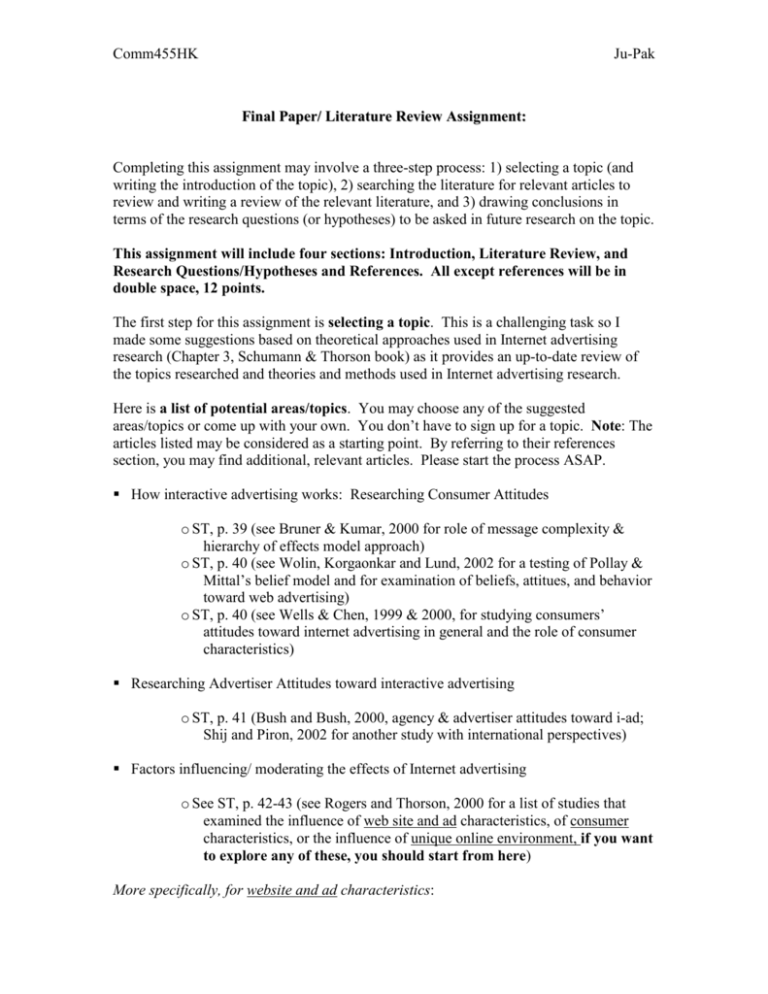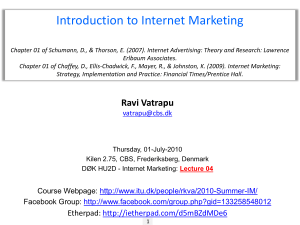Introduction (of your topic in 1
advertisement

Comm455HK Ju-Pak Final Paper/ Literature Review Assignment: Completing this assignment may involve a three-step process: 1) selecting a topic (and writing the introduction of the topic), 2) searching the literature for relevant articles to review and writing a review of the relevant literature, and 3) drawing conclusions in terms of the research questions (or hypotheses) to be asked in future research on the topic. This assignment will include four sections: Introduction, Literature Review, and Research Questions/Hypotheses and References. All except references will be in double space, 12 points. The first step for this assignment is selecting a topic. This is a challenging task so I made some suggestions based on theoretical approaches used in Internet advertising research (Chapter 3, Schumann & Thorson book) as it provides an up-to-date review of the topics researched and theories and methods used in Internet advertising research. Here is a list of potential areas/topics. You may choose any of the suggested areas/topics or come up with your own. You don’t have to sign up for a topic. Note: The articles listed may be considered as a starting point. By referring to their references section, you may find additional, relevant articles. Please start the process ASAP. How interactive advertising works: Researching Consumer Attitudes o ST, p. 39 (see Bruner & Kumar, 2000 for role of message complexity & hierarchy of effects model approach) o ST, p. 40 (see Wolin, Korgaonkar and Lund, 2002 for a testing of Pollay & Mittal’s belief model and for examination of beliefs, attitues, and behavior toward web advertising) o ST, p. 40 (see Wells & Chen, 1999 & 2000, for studying consumers’ attitudes toward internet advertising in general and the role of consumer characteristics) Researching Advertiser Attitudes toward interactive advertising o ST, p. 41 (Bush and Bush, 2000, agency & advertiser attitudes toward i-ad; Shij and Piron, 2002 for another study with international perspectives) Factors influencing/ moderating the effects of Internet advertising o See ST, p. 42-43 (see Rogers and Thorson, 2000 for a list of studies that examined the influence of web site and ad characteristics, of consumer characteristics, or the influence of unique online environment, if you want to explore any of these, you should start from here) More specifically, for website and ad characteristics: Comm455HK Ju-Pak o ST , p. 43 (Li, 1998 and Li & Bukovac, 1999 for a study of cognitive impact of banner advertising, with a version of Elaboration Likelihood Model, dual-processing model approach) o ST, p. 44 (Ahn and Edwards, 2002 for effects of banner characteristics on attitudes; Cho, 1999 ; Dahlen, 2000; Yoo & Stout, 2003) o ST, p. 44 (Yoon, 2000 and Nan, 2003 for effects of celebrity endorsers) o ST, p, 45 (M. Brown, 2002, for effects of different banner types and role of consumer involvement; Dahlen, Rasch & Rosengren, 2003 for effects of websites & involvement) o ST, p. 45 (Yoo & Stout, 2002, effects of positioning in the website) o ST, p. 46 (Li, Edwards, Lee, 2001 & 2002, for effects and measures of intrusiveness) o ST, p. 46-47 (Cho & Leckenby, 1999 for the impact of interactivity on consumer responses to ads; Edwards and Gangadharbtla, 2001, p. 56, M. Lee, Youn, and Larson, 2003 for the impact of 3-D interactivity) For consumer characteristics: o ST, p. 48 (Kwak, Fox, & Zinkhan, 2002 for the impact of consumer involvement and experience; Michel Dahlen, 2001 and Reichheld and Schefter, 2000 for more) o ST, p. 50 (Stafford & Stafford, 1998 & 2000 for the impact of consumer motivation for Internet use) o ST, p. 51 (Jee and Lee 2002 & Yun and Lee, 2003 for the impact of other personal factors) o ST, p. 51 (Patwardham and Yang, 2003 for the impact of consumer media depency) o ST, p. 52 (Menon & Soman, 2002 for the effects of curiosity generation on advertising effectiveness) For Internet characteristics: o ST, p. 52-54 (Roehlm and Haugugtvedt, 1999 & Coyle and Friedman, 1999; Hofman & Novak, 1996; Wu, 1999; McMillan, 2000; Sohn and Leckenby, 2001; Roberts and Ko, 2001; Chung and Zhao, 2003; Sohn, Leckenby & Lee, 2003; Hwang and McMillan, 2002; MaMillan & Hwang, 2002 and many more for interactivity and related factors and theories) o ST, p. 55 (Coyle and Thorson, 2001; Choi, Miracle & Biocca, 2001; Li, Daugherty, & Biocca, 2002 for interactivity, vividness, and telepresence) o ST, p. 54-55 (Burns, 2000 for the effects of self-image) o ST, p. 55 (De Pelsmacker, Geuens, and Auckaert, 2002, for the impact of the media and ad context) Research Other Aspects of Internet advertising o ST, p. 58 (Yoon & Cropp, 1999; Ju-Pak, 1999 (1), International Journal of Advertising, for crosscultural comparison of internet advertising) Comm455HK Ju-Pak o ST, p. 59 (Paptla and Bhatanagar, 2002 for online linking & affiliates/partnership strategies) Introduction (of your topic in 1-2 pages) Address the following: What's the topic area? Why is the topic important to explore? Any theoretical significance (i.e., its potential contributions to the existing body of knowledge or practical value (i.e., its ability to help make practical decisions)? What is known in the area and what is unknown (briefly)? -- this may be written after your preliminary review of the literature Literature Review (10 or so pages) Once you identify the topic of interest, the next step is to write a review of the relevant literature concerning the topic in terms of the theory or theories used, questions and hypotheses researched, the measures used to address the questions or hypotheses, and the findings from the research. While there are many different ways to organize your literature review, please refer to the two examples available (and ST ch.11) to get some ideas. In writing the literature review, include: One or more theories that provide insights into your topic or communication phenomenon of interest The existing literature that reflects, supports, tests or provides insights into the topic area or phenomenon. You will provide a detailed account of what is known about the phenomenon or even variables relevant to the phenomenon (i.e., what variables have been studied/tested-and what have not been- and how they have been defined and measured), and what have been found about their relationship to the phenomenon). Hypotheses or Research Questions (list at least two questions for research in 1 page or less) Usually, reviewing the current literature to learn what specific aspects of the area/topic have been researched and what have been found (not found) may guide you in thinking what questions are worth asking in future research (and what hypotheses are worth testing to learn more specifically about the topic of interest. It is customary to include a separate section for the statements of research hypotheses or questions. Whether to write hypotheses or general questions depends on how much is known about the phenomenon in the literature; use hypotheses if the literature suggests Comm455HK Ju-Pak that specific results will likely be observed regarding the variable or variables and research questions if there is no such basis for expecting certain directional outcome) References (1 page or so in single space) You will include at least 10 research articles in your references section. Please refer to the references section of any ST chapter to learn about the format. More discussion will follow in class.







